Yangtze River Travel Story
Stretching from the highest reaches of the Tibetan Plateau and running all the way to the Yellow Sea at the port of Shanghai, the Yangtze River not only carves the varying landscape of China, but also leaves an impression on all those lucky enough to sail its waters. The Yangtze is China's longest river, reaching almost 4,000 miles in length. The currents, wildlife and surrounding supported foliage differ in each region the river runs through.
While the Yangtze is known to carry large commercial boats and ships in its currents, there are specialized areas, secluded and untouched spots, which are perfect for river cruises. The 400-mile stretch between Chongqing and Yichang allows for visitors to interact with local villagers, witness unique customs and rituals and even come face-to-face with some of China best known animals. Whether you decide on a short 3 day trip, or a longer 10 day journey, the river will show you sites like you have never seen before.
Many tour cruises begin their journey from Chongqing. The municipality, located in southwest China, is home to over 28 million people and one of the five national central cities of the People's Republic of China. Many Yangtze Cruises depart from this area and make their way downstream to the Three Gorges Dam. You could not ask for a better way to open the first chapters in your cruise travel story. Chongqing is an important manufacturing and shipping hub for all of southwest China. It was founded on the local waters, at the intersection of the Jialing River and the upper reaches of the Yangtze. The weather is hot and humid in the summer and mild in the winter. Within the region’s borders lies a wealth of water reserves, mineral resources, dense forests and foliage as well as colorful and abundant flora and fauna.
Since being located so far inland, it is a long trek to Chongqing from other large Chinese cities. An express train from Beijing can take up to 25 hours. The city of Chengdu is much more accessible to Chongqing and is only 2.5 hours away by train. Long distance busses also run service to Chongqing. And of course, the Chongqing Jiangbei International Airport receives flights from all major Chinese cities, as well as some international destinations.
There is so much to see and do in Chongqing, that one can feel overwhelmed at first. But here are a few attractions that we think are the most important in town.

Panda Room in Chongqing Zoo
Panda Room in Chongqing Zoo
Built in 1955, the Chongqing Zoo has long been an established preserve for native Chinese animals. Located in the westerly suburbs of the municipality, the zoo houses well over 200 species of animals, making it is one of the largest urban zoos in the world. Animals such as the South China tiger, native African giraffes, elephants and orangutans are on display. But one of the main reasons that people flock to the zoo, is to see the breeding base for the giant panda! The Giant Panda, the most recognizable animal from China, makes it home in the central western and southwestern regions of the country. It is among the world's most adored and protect animals, especially in China. Its lovable nature is why large, wide-scale efforts have been made to protect the panda's habitat. A depletion of its ecosystem, coupled with a very low birthrate, have labeled the pandas an endangered species. This is exactly what the breeding base here in Chongqing Zoo hopes to turn around.
The Panda Room sees over 1 million visitors a year! The goal here is to raise awareness of the frailty of the species, while providing mother Pandas and their cubs with a safe and thriving environment. The housing for these beloved creatures is 2 hectares just by itself. While there are several other breeding facilities in China, the Chongqing Zoo is one of the few who have actually achieved some success. One of the female pandas here alone had three cubs. The panda room is open daily from 8:00am -6:00pm. And to ensure a peek at the animals, come during the morning and watch the daily feeding. The zoo also has a theme park for kids, quiet rooms and restaurants that are open every day.
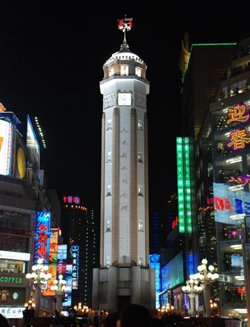
People's Liberation Monument
People's Liberation Monument, Jiefangbei
Erected in 1945, the People's Liberation Monument in Chongqing now commemorates the WWII victory over Japan. Originally named the Monument for the Victory over the Axis Armies, it was renamed its present moniker in 1950 due to the Communist conquest of the vicinity. The stone tower was built on the same spot as a wooden structure used to commemorate Sun Yat-Sen, the first president of the Republic of China. The monument is located in the heart of the commercial and financial center of the municipality. Jiefangbei Square is a bustling city center, comparable to New York's Time Square or London's Piccadilly Circus. Before the skyscrapers and neon lights, there was the People's Liberation Monument. Reaching over 27 meters tall, which is just short of 90 feet, it was once one of the highest structures in Chongqing's oldest districts. Even though it is somewhat dwarfed by modern buildings today, it is still an important and relevant sight to see in the city. If you find yourself in the Yuzhong District, close to Jiefangbei, it is definitely worth the visit. And while in the area, be sure to have a good look around the main walking street and the more than 3,000 stores, two dozen malls and shopping outlets, multiple lavish hotels and vast offices that house banks, telecommunications companies and stock markets.
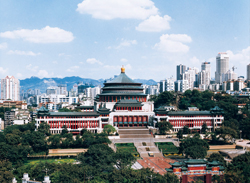
The Great Hall of the People
The Great Hall of the People
The Great Hall of the People is another sight in the municipality that is well worth visiting, if given the time. The Hall, along with the People's Square in front, is an architectural symbol of Chongqing. Although a modern building, its design was based on traditional Chinese architecture. The open-air square in front of the hall was more recently completed and is often a space used for outdoor performances. You might even be lucky enough to catch a light show at night in the square. And once in the area, check out the Three Gorges Museum, which sits directly across from the Great Hall and People's Square. The museum highlights the cultural history of the Ba, the history of the Three Gorges Dam project and the surrounding area of the Three Gorges. Other notable and interesting exhibitions are frequently rotated on display. All three of these great attractions can be found in the Yuzhong district of Chongqing.
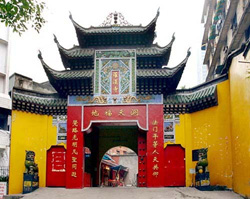
Luohan Temple
Old Chongqing Street and Luohan Temple
If you are looking for a more traditional area of the city, Old Chongqing Street is the place to be. The pedestrian-only streets are located in the Yuzhong Peninsular of the city. The Shibati Old Street links the modern world with the traditional, the new with the old. The name literally means ’18 Steps” and harks back to the time of the Ming Dynasty when an old fresh water well was located just eighteen steps from the houses. The narrow lanes are paved only in stone blocks and are encased in low traditional styled residential buildings. The street will make you feel as if you have truly stepped back in time. It is a slower pace of life here, and it’s hard to believe that it’s situated right in the middle of a bustling metropolis. Traditional Chinese trades still do business out of these streets. Everything from foot massagers to carpenters can be found on Shibati. And it is a taste of the past, while not having to go as far as Ciqikou Old Town, mentioned below.
For a taste of religion in the area, the beautiful Luohan Temple, or Luohan Si, is located in the city. Built over 1000 years ago during the reign of the Song Dynasty, the Luohan has seen Chongqing go through many changes. And the temple has gone through them as well. It was rebuilt after devastating damages in 1752 and then again in 1945. It is a popular place for worship, and although used to be bigger, still houses a small community of loyal monks. One reason many people visit Luohan is to get a glimpse of the 500 painted clay Arhats. In Buddhism, an Arhat is a spiritual practitioner that has fully realized and obtained high stages of attainment, thus freeing himself of material greed. Tea and a vegetarian lunch are served daily at the temple. Daily opening hours are from 8:00am to 6:00pm. It’s address is 7 Louhan Si, Chongqing and costs 10rbm to enter.
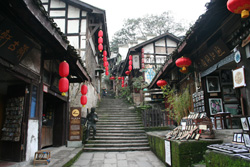
Ciqikou Old Town
Ciqikou Old Town
Less than an hour's drive west from Chongqing and centuries back in time, the Ciqikou Old Town is a great respite from the industrious municipality. Chongqing has changed and adapted to the present times. But things in Ciqikou are a little different. They are a little slower paced. And pretty accurate to how things might have been hundreds of years earlier. The town is quite old, some says it dates back over 1500 years, and became prominent in the Ming and Qing Dynasties. Precious porcelain was produced along the Jia Ling River banks. The town was originally called Bauyan Town, then Longyin Town and finally renamed Ci Qi Kou, which translates to ‘Porcelain Village’ or ‘Porcelain Port’. Located right on important ancient trading routes, the town become an important port and trading post for travelers making their way up and down the river ways. Follow the large flagstones up from the river and see the commercial prevalence still present today. Large numbers of shops line the two main streets. Booths filled with hand carved crafts, clocks, herbs, drugstore supplies, snacks like roasted nuts and seeds and the popular hand-twisted fried dough are jam packed into the streets. Tea bars and traditional restaurants fill the lanes with the hint of fragrant spices.
But Ciqikou isn't just filled with monotonous souvenirs. Make sure to check out the Shu Embroidery workshop. This meticulous art form has been passed on from generation to generation. The ladies who work their magic here are some of the best embroidery craftsmen in all of China. Artists also frequent the streets in a large array of styles and forms. Most produce one-of-a-kind works out in the open and give tourists a good look into how the mini-masterpieces are made. Ciqikou is also known for its Tea Bars. There are more than a hundred to choose from, and each one is different from the next. Each shop has its own unique program. Some teahouses have entertainment such as stages shows, or possibly small folk opera performances and still other shows similar to magic or slight of hand tricks. The teahouses provide a social gathering place for locals and visitors alike.
Between the traditional bamboo and timber architecture and the laid back way of like, Ciqikou Old Town is bound to have something for every traveler, no matter the age or background. Plus, one of the most notable highlights, the town is always free of charge to enter. Enjoy every last bit of its traditional Chinese folk culture!
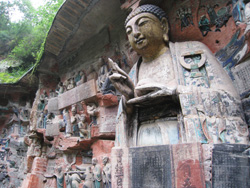
Dazu Grottoes (Baodingshan)
Dazu Grottoes (Baodingshan)
If you are looking to escape the concrete jungle for a day, venture out to Dazu, around a 2-hour trip outside of Chongqing. On the far reaches of the Chongqing municipality, Dazu might seem like a sleepy, boring retreat. But there is something hidden in the surrounding grottos that will leave you speechless.
Just 9 miles, 15 kilometers, east of Dazu lies the spectacular Baodingshan, or known by its English name, Treasured Summit Hill. When walking up to the World Heritage Site, visitors are greater by a series of Chinese religious sculptures dating back to the 7th century. Representations of Buddhist, Taoist and Confucian beliefs have been meticulously carved out of the native stone. The harmony of the three believes and the understanding and tolerance of each different religion is evident. The total number of statues soars above 50,000! And there are another 100,000 or so carvings of Chinese characters inscriptions. It is a beautiful and vast collection of some of the best preserved rock carvings in the world. The statues began to take form in the Tang Dynasty era and continued for hundreds of year. Legend has it that some monks even dedicated their entire life to perfecting and adding to this vast collection.
Unlike many other vandalized religious sites in the area, the Dazu carvings remained unscathed during the Cultural Revolution. These statues and caves were quite unknown and even forbidden to visit by travelers up until 1961. Chinese tourists were allowed to visit the site in the 1960s and it was opened for any one to visit in 1980.
Dazu can be reached by bus from Chongqing. The caves are open from 8:00am to 6:00pm and are also accessible by bus from Dazu. To reach Treasure Summit Hill, take the Boa Ding Shan bus at the Longzhong Road bus station. It is around a 40 minute ride up to the main entrance of the Treasured Summit Hill visitor’s area. The there is an additional 30 minute walk from there up into the caves. Tour carts are also available for a small fee for those tourists not able to climb the hill on their own.
Dazu also has a variety of other places to visit while in the city. The second most popular attraction is the Beishan, which is just a little over a mile outside the city. It includes several statues, like the ones in at the Treasured Summit Hill, and a pagoda. For more rock carvings, check out Nanshan, Shimenshan and Shizhuanshan. While not as large or numbering in artifacts as Baodingshan, they are still interesting and worth the visit if you want to see more. All are accessible by taxi from the city.
For other, off-the-beaten-path adventures outside of Chongqing, you may want to try the Dafo Temple. The temple is known for a large Buddha carved right out of the surrounding rock landscape. The statue stretches several meters high. The people in Tongnan, the city of the temple, are friendly, very welcoming and curious to know all about the outsider tourist. The city and temple can be reached by bus from the long distance bus station in Chongqing. Tongnan is about 2 hours north of the municipality.
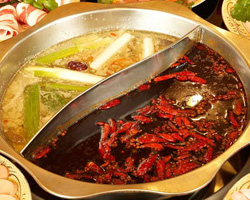
Chongqing food - Hotpot
Chongqing food
With so much sightseeing, any tourist is sure to work up a huge appetite. The dockside culture, literally being born from the highway waters, is responsible for the creation of Hot Pot. It is unique to Chongqing and a claim to fame for many of the residents. While it might be found in other parts of China, Hot Pot was born here and is done right here.
What is Hot Pot exactly? Similar to western meat fondues, Hot Pot restaurants have tables with central vats filled with spicy or savory broth. Customers cook their own meats, seafood, and vegetables in the central pot. It is an experience like no other!
There are three main choices for a Hot Pot meal. One version of the broth is spicy, and called red soup, or hong tang. Consider yourself warned that Chongqing is known for it's hot spices and almost mouth-numbing food. When you order spicy, be prepared! For those who are looking for a savory, mild taste, try the Yuan Wei, which foregoes the spices. This is more similar to a stock broth or bone soup. And then finally there is the Yuan Yang Hot Pot, or the Yuan Yang Huo Guo. This is the best of both worlds. It's a pot that is split down the middle into spicy on one side and mild on the other. With this dish, everyone at your table can enjoy which Hot Pot they like best.
E Zhang Men is a popular Hot Pot chain restaurant. Currently boasting over 14 locations throughout Chongqing, one is sure to be near your overnight accommodations. Xiao Tian E, also known as the Cygnet Hot Pot Plaza, located in the Jiangbei district and Su Da Jie in the HongCheng Mansion on TianXing Bridge, are two additional Hot Pot restaurants that come highly recommended. For a more upscale experience, try the Chongqing 5-Star Harbour Plaza for great Hot Pot in a warm and cozy atmosphere.
Sichuan Cuisine is also very popular in Chongqing as well. Even though the municipality has been independent since 1997, it was originally historically associated with Sichuan and still shares common love for those mouth burning spicy dishes that the region is famous for. Originating in the Sichuan province in western China, the food is known for it’s fresh tastes and hot spices. Because of the warm, humid days in Chongqing, peppers grow hotter and spicier than in other cooler regions. This upped the temperature in all local Sichuan dishes, and soon, spicy became the new norm.
Local snacks can be found all over the city. For some Chongqing favorites, try a platter of the Sticky Rice Balls or the Steamed Bun with Stuffing. And for lunch and dinner, keep in mind some of these fresh local tastes when ordering. Especially popular in Chongqing are the Twice Cooked Spicy Pork, Fish Flavored Eggplant, Beef Slices in Hot and Spicy Soup and the mouth numbing Spicy Tofu.
For those looking for a more western style of dining, Chongqing has plenty to offer. One of the preferred western style restaurants is Friendship Restaurant. Located next to the Maison Mode Plaza, this spot offers good food, English menus and comes highly recommended by many travelers. It is located in the Jiefangbei Square in the Yuzhong district, and is also where other western and upscale restaurants can be found. For a thick, juicy steak, why not try the Manhattan Steakhouse in the Marriott Hotel located in the Yu Zhong District. The restaurant specializes in classically prepared imported cuts of beef and boasts an array of fresh seafood as well.
As for souvenirs or local tastes to take along with you on your river cruise, local favorites such as Preserved Dried Beef( Niu Rou Gan), Spicy Fine Beef Threads (Deng Ying Niu Rou ), Flavoured Horsebean (Guai Wei Hu Dou), Pulverous Nuby Peach (He chuang Tao Pian) all come highly recommending and are unique to the city.
Many walking, riding and privately guided sightseeing tours of the Chongqing are available. But no matter how you choose to see the city, whether you hustle to all the stops, and linger at a prized few, you are sure to be enchanted be the modern, sophisticated and important Chongqing.
A typical itinerary begins by setting sail downstream towards the Three Gorges Dam. Since the journey can be stretched out over multiple days, there are a variety of stops and sights to see along the way.
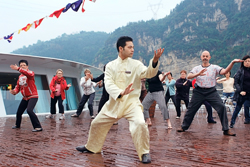
Taichi Learing on Yangtze Cruise Board
Yangze Cruise Experience
After the first night out on the Victoria Jenna, the tour boat will slow and make a stop its fist stop at Fengdu. There is over 75 Buddhist and Tao temples in the city of Fengdu, most of which are nestled up on a hill on Ming Mountain. Not only is the town shrouded in mysterious, ghostly presences and protectors, but there is also a necropolis in the vicinity that was modeled after the Chinese Hell in Taoist mythology. Lifelike statues of ghosts, demons and spirits of legends are carved out of white, luminous stone, giving them an air of otherworldliness. Chinese Lunar festivals in the first half of March bring many visitors and believers to the city. In addition to the eerie statues, Fengdu is home to the largest in-situ statue in the world. Nicknamed The Ghost King, the carving is massive at 138 meters (452 feet) high. Most visitors to the spot arrive by boat and spend a few hours at this delightfully phantasmal tourist site.
From Fengdu, the boat continues down the river. Most of the second day and the first part of the third day are reserved for sailing. While on board, guests will enjoy the surround landscape and rich, supporting waters. Breakfast, lunch and dinner are provided in the tour, as well as on board entertainment to pass the quieter moments. Rest assured that the majority of tour boats are upheld to the highest of standards. Ships often come equipped with comfortable rooms, complete with private bathrooms, clean, soft linens and secluded balconies for an individualized viewing experience. Cruises are also usually stocked with amenities such as living and television areas, fitness centers, a health clinic, on-board Internet access and international phone service. As for entertainment, jazz lounges, bars, spas, and discos are often found on board as well. Throughout the trip, special dinners are held and cultural activities live singing, dancing and folk performances can be viewed nightly. It is everything you would expect on a 5 star vacation, if not more.
Continuing on your Yangtze River cruise, the first gorge that the boat will pass through is the Qutang Gorge. It is quite the sight to see. The surrounding riverbanks begin to climb and narrow as the mountainous region envelops the Yangtze. Towering above the gorge are bluffs on either side. They are said to resemble royal guards keeping a close eye on a protected door. The water rushes through the Qutang Gorge with great forces. The racing water below and the cliffs above make tourist feel as if they have fallen into a deep chasm. You are going to want to be on deck for this spectacle!
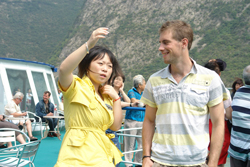 Just after passing through Qutang Gorge, the cruise ship will slowly enter Wu Gorge. The beauty here is unmatched and has been inspiring artists for years. Lush green flora covers the banks and surrounding hills. Towering distant peaks, called the Twelve Peaks of Wu Gorge, are often shrouded in fog. The soft mist gives the mountains an air of mysticism and magical qualities as they disappear and reappear in front of your eyes. Be on the lookout for waterfalls, which dot the cruise’s path. Time your trip perfectly with good weather, set up camp on one of the upper boat decks or private balconies and prepare to be amazed at the diverse and beautiful landscape that the Yangtze has to offer.
Just after passing through Qutang Gorge, the cruise ship will slowly enter Wu Gorge. The beauty here is unmatched and has been inspiring artists for years. Lush green flora covers the banks and surrounding hills. Towering distant peaks, called the Twelve Peaks of Wu Gorge, are often shrouded in fog. The soft mist gives the mountains an air of mysticism and magical qualities as they disappear and reappear in front of your eyes. Be on the lookout for waterfalls, which dot the cruise’s path. Time your trip perfectly with good weather, set up camp on one of the upper boat decks or private balconies and prepare to be amazed at the diverse and beautiful landscape that the Yangtze has to offer.
During the third day, the cruise will make a small excursion to the Daning River Small Gorge. The Daning is a main tributary to the Yangtze and covers over 250 kilometers (150 miles). In contrast to much of the Yangtze, the Daning is quite clean, clear and bright green. The trip to the three Small River Gorges will take you and your group though the Longmen Gorge, the Bawu Gorge and the Dicui Gorge. Impossible to imagine, but the scenery here is just as beautiful, if not more so, than that of the Wu Gorge. Waterfalls, plant and flower life, as well as river wildlife, are easily spotted on this adventure. Look up and try to locate the Ancient Plank Road up on the high cliffs above. This serene side trip will be a perfect way to relax, unwind and really enjoy all of the Yangtze’s beautiful scenery.
After sailing back onto the Yangtze, the cruise itinerary is set to take you through the Three Gorges Ship Locks. The ship locks are used to make shipping, traveling and transportation on the Yangtze more efficient, faster and cost-worthy. They have upped the millions of tons of freight capacity on the river by ten fold. Each ship locks is made up of 5 stages and can take up to 4 hours to pass. The locks stretch just under 300 meters (around 900 feet), just 35 meters (115 feet) wide and raise or lower the level of the water to allow large ships to bypass river obstructions such as dams or rapids. Traveling through the ship locks is a one of a kind experience. The contrasting technology and industrialism with the beautiful surrounding scenery make for an interesting comparison.
Day four of the cruise also allows ample time for visiting the Three Gorges Dam site. The Three Gorges Project, consisting of the dam, ship locks and a hydroelectric station, are one of the modern wonders of the world. Being able to control some of the most traveled waters in the world allows China and its economy to grow rapidly and efficiently. The dam itself is massive. It stretches a distance of close to 2,300 meters (7,500 feet, over one mile!) and is around 115 meters (375 feet) wide. Building this project has required almost 30 million cubic meters of concrete. The completion of the dam in 2006 had great impact on the Yangtze. The newly dammed area now rests 175 meters (575 feet) above sea level. Harnessing the power and force of the river, the hydroelectric station powers millions of people in the surrounding area and is the largest of its kind. The dam also prevents potential devastating flooding downstream by allowing for give in its flood storage space.
There is no hiding the fact that the Three Gorges Project has been both welcomed and controversial. While some see it as a true engineering marvel, others are concerned about its effect on local Yangtze wildlife and other environmental issues. Although both sides have valid arguments, it is refreshing to see that local people are already benefiting from the safety and power generated by the dam. Being one of the largest and best-known structures in the world, it is sure to be the highlight of your Yangtze River cruise.
After lunch on the fourth day, you will disembark in Yichang. Located downstream from the Three Gorges Project, Yichang is an important port on the river. Often referred to the “Gateway to the Three Gorges” the city has lots to see and experience. If staying in Yichang for a while after the cruises completion, check out the Chinese Sturgeon Museum, Sanyou Cave or Baima Cave, the Xiaoting Ancient Battlefield or take to the waterways again for a Shennong Stream excursion. Or feel free to just enjoy the city for all that it has to offer. A city as big as Yichang will keep visitors busy for each day.
For those tourists that have chosen the itinerary that circles back to Chongqing, you will travel to the Three Gorges first, and then make a side trip to Fengdu and once again will be taken back in Chongqing.
Cruises of all sizes and lengths are available. Most run year round, with up to two departures a week. With so many options, there is sure to be a cruise to fit into your trip and your budget.



